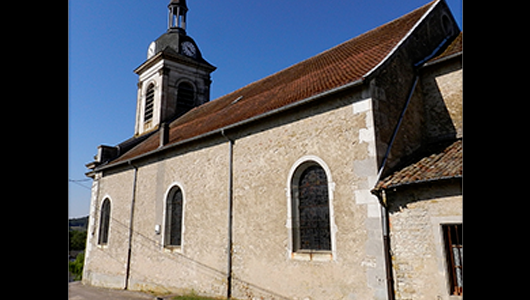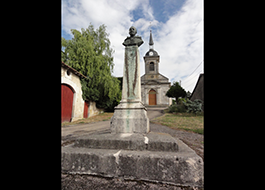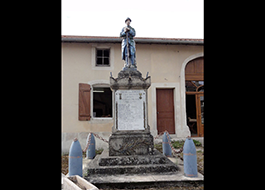Ménil-la-Horgne
Durée visite : 30 minutes
Moyen : Pédestre
Les villages de Ménil et La Horgne sont réunis en 1700. La Révolution détruit l’abbaye de Riéval, établie par les Prémontrés en 1124. En 1180, le legs du maire Descontes permet la création d’une école de bergers, puis une d’école d’agriculture. Elles sont fermées au début des années 1960. Le village est la patrie du célèbre historien bénédictin Dom Calmet.
The villages of Ménil and La Horgne were reunited in 1700. The Revolution destroyed the abbey of Riéval, established by the Premonstratensians in 1124. In 1180, the bequest of the mayor Descontes allowed the creation of a school of shepherds, then one of agricultural school. They were closed in the early 1960s. The village is the homeland of the famous Benedictine historian Dom Calmet.
Die Dörfer Ménil und La Horgne wurden 1700 wieder vereint. Die Revolution zerstörte die Abtei von Riéval, die 1124 von den Prämonstratensern gegründet wurde. 1180 ermöglichte das Vermächtnis des Bürgermeisters Descontes die Schaffung einer Hirtenschule, die damals eine Landwirtschaftsschule war . Sie wurden in den frühen 1960er Jahren geschlossen. Das Dorf ist die Heimat des berühmten benediktinischen Historikers Dom Calmet.

D’azur au chevron haussé d’argent accompagné en chef de deux abeilles en vol d’or et en pointe d’une gerbe de blé du même.
Création Robert A. Louis. Adopté en décembre 2013.
Azure, a chevron raised Argent accompanied in chief of two bees in flight Or and in base of a sheaf of wheat of the same.
Creation Robert A. Louis. Adopted in December 2013.
Azure, ein Chevron, der Argent großgezogen hatte, begleitete den Chef zweier Bienen im Flug oder auf der Basis eines Weizengarbens desselben.
Schöpfung Robert A. Louis. Im Dezember 2013 verabschiedet.

Les habitants et les habitantes de Ménil-La-Horgne s’appellent les Horgniaux.
The inhabitants of Ménil-La-Horgne are called the Horgniaux.
Die Einwohner von Ménil-La-Horgne heißen Horgniaux.
Les points de visites
.
L’église date de 1840, mais ses fonts baptismaux sont du XVIIIe siècle. En pierre polychrome, ils proviennent probablement de l’abbaye de Riéval. C’est la troisième église construite dans la commune. La première, située dans le hameau de Sorbey, desservait Ménil et La Horgne. Elle a été démolie au début du XVIIIe siècle. La seconde, brûla dans l’incendie du village en 1723. Même les cloches fondirent. Saint Bénigne aurait évangélisé la Gaule et serait mort en martyr en 179. En fait, c’est l’évêque de Langres au VIe siècle qui inventa son tombeau. Il le substitua à des reliques païennes vénérées par ses ouailles. Ce fut une pratique courante à l’époque. Elle visait à reprendre en main la dévotion populaire, et à l’orienter vers des figures orthodoxes, sinon toujours authentiques.
The church dates from 1840, but its baptismal font is from the 18th century. In polychrome stone, they probably come from the Abbey of Riéval. It is the third church built in the town. The first, located in the hamlet of Sorbey, served Ménil and La Horgne. It was demolished at the beginning of the 18th century. The second burned down in the village fire in 1723. Even the bells melted. Saint Bénigne would have evangelized Gaul and would have died as a martyr in 179. In fact, it was the bishop of Langres in the 6th century who invented his tomb. He substituted it for pagan relics venerated by his flock. It was common practice at the time. It aimed to regain control of popular devotion, and to orient it towards orthodox figures, if not always authentic.
Die Kirche stammt aus dem Jahr 1840, ihr Taufbecken stammt jedoch aus dem 18. Jahrhundert. Aus polychromem Stein stammen sie wahrscheinlich aus der Abtei von Riéval. Es ist die dritte Kirche in der Stadt. Die erste im Weiler Sorbey diente Ménil und La Horgne. Es wurde zu Beginn des 18. Jahrhunderts abgerissen. Die zweite brannte 1723 im Dorfbrand nieder. Sogar die Glocken schmolzen.Der Heilige Bénigne hätte Gallien evangelisiert und wäre 179 als Märtyrer gestorben. Tatsächlich war es der Bischof von Langres im 6. Jahrhundert, der sein Grab erfand. Er ersetzte es durch heidnische Relikte, die von seiner Herde verehrt wurden. Es war damals übliche Praxis. Ziel war es, die Kontrolle über die Hingabe der Bevölkerung zurückzugewinnen und sie an orthodoxen Figuren auszurichten, wenn auch nicht immer authentisch.
.
.
Ce buste en bronze date du début du XXe siècle. Dom Calmet est né à Ménil-la-Horgne en 1672. Son père était maréchal-ferrant. Doué, il entre au prieuré bénédictin de Breuil, puis à l’université de Pont-à-Mousson. À la fin de ces études, il rejoint les bénédictins de Saint-Vanne. En 1689, il prononce ses voeux à l’abbaye Saint-Mansuy de Toul. Il étudie la philosophie dans cette ville, puis la théologie à Munster. Il est ordonné prêtre en 1696. Il commente les saintes Écritures dans l’abbaye de Moyenmoutier et à Munster. Il parcourt divers monastères de son ordre, dévorant les livres et rédigeant des compilations historiques. En 1728, Dom Calmet devient abbé de Senones, la capitale de la principauté de Salm. Il y mourut en 1757. Auteur de nombreux ouvrages sur la Bible et l’histoire de la Lorraine, il entretient une correspondance avec des savants de son époque. Il accueille même Voltaire, exilé de France. Celui-ci se moque des écrits, pourtant critiques, de son hôte sur les vampires, mais consulte ses autres livres pour ses propres ouvrages.
This bronze bust dates from the beginning of the 20th century. Dom Calmet was born in Ménil-la-Horgne in 1672. His father was a farrier. Gifted, he entered the Benedictine priory of Breuil, then the University of Pont-à-Mousson. At the end of these studies, he joined the Benedictines of Saint-Vanne. In 1689, he pronounced his vows at the Saint-Mansuy abbey in Toul. He studied philosophy in this city, then theology in Munster. He was ordained a priest in 1696. He comments on the Holy Scriptures in the abbey of Moyenmoutier and in Munster. He travels through various monasteries of his order, devouring books and writing historical compilations. In 1728, Dom Calmet became abbot of Senones, the capital of the principality of Salm. He died there in 1757. Author of numerous works on the Bible and the history of Lorraine, he maintains correspondence with scholars of his time. He even welcomed Voltaire, exiled from France. This one mocks the writings, however critical, of his host on vampires, but consults his other books for his own works.
Diese Bronzebüste stammt aus dem Anfang des 20. Jahrhunderts. Dom Calmet wurde 1672 in Ménil-la-Horgne geboren. Sein Vater war Hufschmied. Begabt trat er in das Benediktinerkloster von Breuil ein, dann in die Universität von Pont-à-Mousson. Am Ende dieser Studien schloss er sich den Benediktinern von Saint-Vanne an. 1689 legte er in der Abtei Saint-Mansuy in Toul sein Gelübde ab. Er studierte Philosophie in dieser Stadt, dann Theologie in Münster. Er wurde 1696 zum Priester geweiht. Er kommentiert die Heilige Schrift in der Abtei von Moyenmoutier und in Münster. Er reist durch verschiedene Klöster seines Ordens, verschlingt Bücher und schreibt historische Zusammenstellungen. 1728 wurde Dom Calmet Abt von Senones, der Hauptstadt des Fürstentums Salm. Er starb dort 1757. Er ist Autor zahlreicher Werke zur Bibel und zur Geschichte Lothringens und unterhält Korrespondenz mit Gelehrten seiner Zeit. Er begrüßte sogar Voltaire, der aus Frankreich verbannt wurde. Dieser verspottet die noch so kritischen Schriften seines Gastgebers über Vampire, konsultiert aber seine anderen Bücher für seine eigenen Werke.
.
Un Poilu est représenté en sentinelle. Des guirlandes de laurier, la Médaille militaire et la Croix de guerre ornent le monument. Des obus l’entourent. Quatorze enfants de Ménil y figurent. Plusieurs fratries ont été fauchées. Le caporal Evrard, titulaire de la Croix de guerre, est mort de maladie quinze jours après l’armistice. Le sculpteur est le toulousain Etienne Camus, auteur prolifique de monuments aux morts, environ 630. Il les produisait en série avec son beau-père Miquel. Celui-ci éditait un catalogue proposant des modèles auprès des mairies de France. 95% des communes françaises possèdent un monument aux morts.
A “poilu” is represented as a sentry. Laurel garlands, the Military Medal and the Croix de Guerre adorn the monument. Shells surround him. Fourteen children of Ménil appear there. Several siblings were mowed down. Corporal Evrard, holder of the Croix de Guerre, died of illness fifteen days after the armistice. The sculptor is Etienne Camus from Toulouse, prolific author of monuments to the dead, around 630. He produced them in series with his father-in-law Miquel. This published a catalog offering models to the town halls of France. 95% of French municipalities have a war memorial.
Ein « Poilu » wird als Wachposten dargestellt. Lorbeergirlanden, die Militärmedaille und der Croix de Guerre schmücken das Denkmal. Muscheln umgeben ihn. Dort erscheinen vierzehn Kinder von Ménil. Mehrere Geschwister wurden niedergemäht. Corporal Evrard, Inhaber des Croix de Guerre, starb fünfzehn Tage nach dem Waffenstillstand an einer Krankheit. Der Bildhauer ist Etienne Camus aus Toulouse, ein produktiver Autor von Denkmälern für die Toten um 630. Er produzierte sie in Serie mit seinem Schwiegervater Miquel. Dies veröffentlichte einen Katalog mit Modellen für die Rathäuser von Frankreich. 95% der französischen Gemeinden haben ein Kriegsdenkmal.








